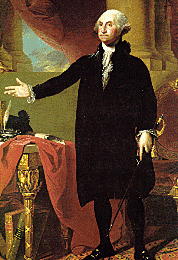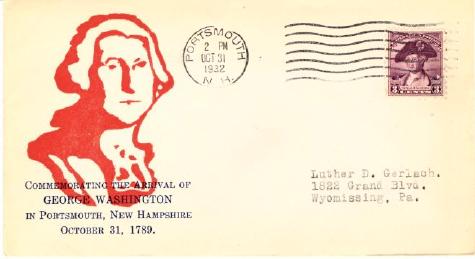| George Washington's Seacoast Tour |

PRESIDENTS IN NEW HAMPSHIRE
There was a time when everyone in America wanted the same man for President. And he came with royal pomp to Portsmouth in 1789. GW visited NH's future governor John Langdon. He had his portrait painted. He stopped in to see the mother of his Portsmouth-born secretary Tobias Lear. Washington wrote in his journal the the Portsmouth women were quite attractive. Read on.
THE FIRST GW TOUR
October 31 - November 4, 1789
VISIT our TOBIAS LEAR section
For an 18th century New Hampshire citizen, the historic moment packed all the thrill of a moon walk. The first American President took his first step onto New Hampshire soil in a burst of celebration. Revolutionary spin-doctors would have placed George Washington's popularity rating in October 1789 on a scale somewhere between a king and a god. People loved the conquering general whose name remains a synonym for democracy.
With his precedent-setting decision to tour all of the United States while in office, Washington used his popularity to sew together the loosely knit and increasingly derisive confederation of states at a critical time. His four week New England journey, later followed by a tour of the South, brought Washington from New York, Connecticut and Massachusetts to the banks of the Merrimack River on October 31. Having previously traveled up the North Shore coast from Salem, Washington breakfasted in Newburyport, but traveled a few miles inland to find a shallow spot to cross the Merrimack River. At a point on the Amesbury road, historians believe, he was ferried across the state line as local militia and lighthorsemen ceremoniously made the border exchange.
John Sullivan, "the president" of New Hampshire, out-pomped his neighbor states by assembling a long receiving line of NH's political elite and an escort of 700 cavalry. Though Seabrook is not mentioned in the accounts, the day trip apparently moved from there through Hampton Falls, Hampton and to Greenland where Washington rode past cheering citizens on horseback.
READ WASHINGTON'S ACTUAL DIARY
All Hail Washington!
The Presidential parade arrived in Portsmouth at 3 p.m. along what is today Middle Street. Newspaper accounts describe narrow streets packed with cheering onlookers, church bells and 13-gun salutes to honor the united colonies (though Rhode Island and North Carolina were not yet officially members.) The changing times are evident in the rapidly changing street names. King Street, for example, had only years before been changed to Congress Street . Since Portsmouth was then the New Hampshire capital city, Washington marched up Congress Street into Market Square where citizens sang lengthy original odes to the tune of "God Save the King". A published sample verse reads:
"Those shouts ascending to the sky,
Proclaim great WASHINGTON is nigh!
Hail Nature's boast -- Columbia's Son,
Welcome! Welcome WASHINGTON."
Washington was received at the State House which no longer stands in the square. Children wearing hats with colored quills to designate their schools had been assigned to the front row Because Washington's whistle-stop New England tour had been suddenly announced, townspeople prepared the elaborate ceremony in just two days.
 After the festivities, the President took lodging in the Brewster Tavern on the corner of modern day Court and Pleasant Streets. That building too no longer stands, but after dinner with local VIPs, Washington records that he took tea at John Langdon's fine home next door, an historic site still open to the public. Langdon, a NH senator and ship builder, had recently tussled with John Paul Jones over equipping of the tall ship America. November 1 was a Sunday and Washington attended morning church services a few blocks walk toward the harbor at St. John's Episcopal. The current brick church at the top of Chapel Hill was rebuilt when the wooden one burned in 1806. Attending a second afternoon service was customary. With his secretary Tobias Lear of Portsmouth, the Chief Executive heard a very flattering speech at the North Church in Market Square. Only the weathervane of this Portsmouth landmark remains of the structure Washington visited. According to Washington's journal, he spent the afternoon in his room at the tavern writing letters.
After the festivities, the President took lodging in the Brewster Tavern on the corner of modern day Court and Pleasant Streets. That building too no longer stands, but after dinner with local VIPs, Washington records that he took tea at John Langdon's fine home next door, an historic site still open to the public. Langdon, a NH senator and ship builder, had recently tussled with John Paul Jones over equipping of the tall ship America. November 1 was a Sunday and Washington attended morning church services a few blocks walk toward the harbor at St. John's Episcopal. The current brick church at the top of Chapel Hill was rebuilt when the wooden one burned in 1806. Attending a second afternoon service was customary. With his secretary Tobias Lear of Portsmouth, the Chief Executive heard a very flattering speech at the North Church in Market Square. Only the weathervane of this Portsmouth landmark remains of the structure Washington visited. According to Washington's journal, he spent the afternoon in his room at the tavern writing letters.
CONTINUE WITH WASHINGTON TOUR
WASHINGTON TOUR OF PORTSMOUTH, NH
Historic Harbor Tour
Washington's third day in New Hampshire is best summarized in his own words: "Monday 2d. Having made previous preparations for it, attended by the President (John Sullivan), Mr. Langdon and some other Gentlemen, I went in a boat to view the harbour of Portsmouth: which is well secured against all winds; and from its narrow entrance from the Sea and passage up to the Town, may be perfectly guarded by any approach by water...The anchorage is also good, and the shipping may lay close to the Docks, etca., when at the town.
In my way to the Mouth of the harbour, I stopped at a place called Kittery, in the Province of Maine, the river Piscataqua being the boundary between New Hampshire and it. From thence I went to the old Fort (formerly built while under the English government on an Island which is at the entrance of the harbour, and where the Light House stands. As we passed this Fort we were saluted by 13 Guns. Having Lines, we proceeded to the Fishing banks a little without the Harbour, and Fished for Cod; but it was not being a proper time of tide, we only caught two, with w'ch, about 1 o'clock, we returned to town. "
It isn't known whether Washington's boat ride was the germ of the idea for the country's first naval shipyard in Kittery. Although the current structures are not of Washington's era, the lighthouse and Fort William and Mary are in the harbor at what was Great Island, now the town of New Castle. Historians debate whether the Chief Executive also stopped by Fort McClary in Kittery and visited a former British Governor Col. Michael Wentworth at what is today the preserved Wentworth-Coolidge Mansion that sits right on the river In Portsmouth.
That afternoon Washington heard a laudatory address and dined with a "Circle of Ladies" at the Langdon's. According to his notes, he retired for the evening at 7 p.m. at the tavern and wrote a response letter to the town of Portsmouth, as well as letters to Newburyport and Marblehead which he had not yet finished.
Weeks earlier in Boston, Washington had been too busy to sit for a portrait to be hung in Fanieul Hall. But the aggressive Dutch-born artist, Christian Gullager had pursued Washington to Portsmouth and on Tuesday the President posed two hours for the portrait (see picture at top of this page). After a meeting further down Court Street at the Pitt Tavern, now part of Strawbery Banke, Washington made a personal visit. He passed through the residential Puddle Dock area near the Liberty Pole at what is now Prescott Park. Here, free of the crowds and adulation, the first Commander in Chief of the United States of America took a quiet moment to visit the family of his loyal secretary Tobias Lear in a house now open to the public next to the Wentworth-Gardner Mansion.
By evening Washington was back in the thick of things, attending a gala with up to 75 handsome local ladies and their escorts at the grand downtown Assembly Hall. The local newspaper reported that 11 toasts were offered and it is assumed the famous freed slaves, Prince Whipple and his brother Cuffee, were in attendance. The President, who usually retired early, stayed until 9 p.m.. He had requested no ceremonies surrounding his departure and at 7:30 the next morning, Washington and his eight staff members slipped quietly out of town by carriage en route to Haverhill, Massachusetts.

Fast Exit Via Exeter
Wednesday, November 4 was his last day in New Hampshire. Washington records that they made the 14 mile journey back via Greenland to Exeter, arriving by 10 a.m. It seems likely he stopped in Stratham to pay his respects to Paine Wingate, the other NH state Senator serving with Thomas Langdon who had monopolized the President's attention for days. In his journal, Washington noted that Exeter was the state's second most important town, yet he passed through on horseback in just one hour. He seemed unaware of the jealousy between the rival towns and recorded mostly details of the many water falls and factories there. Stopping at the Folsom Tavern with Major Nicholas Gilman, Washington refused, and later regretted, an invitation to stay the night.
Despite Exeter's key role in Revolutionary politics, the President departed quickly, and passing through the colonial village of Kingston, most likely made a final stop. Kingston was home to Doctor Josiah Bartlett, then a founding member of the U.S. Supreme Court, past signer of the Declaration of Independence and soon to be the first governor of New Hampshire. In his book, George Washington in New Hampshire, author Elwin Page notes the irony of Washington's inconspicuous departure in contrast to the pomp of his arrival. In ill health, without attending VIPs, cheering crowds, body guards, militia or media reporters, Washington passed through the little town of Plaistow, slipped back across the Merrimack River and out of New Hampshire.
OUTSIDE LINK:
Washington Papers at the LIbrary of Congress
Copyright © 1997 by By J. Dennis Robinson at SeacoastNH.com. Updated 2004. All rights reserved. Full length Washington portrait from White House official web site.
Primary Source: George Washington in New Hampshire by Elwin Page. Originally published in 1932, later republished by the Portsmouth Marine Society, now out of print. .
